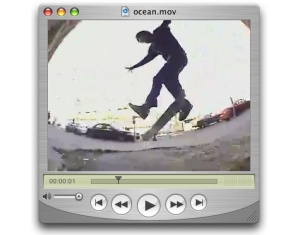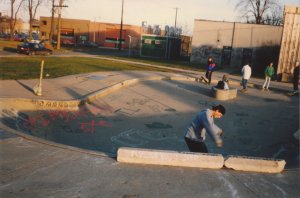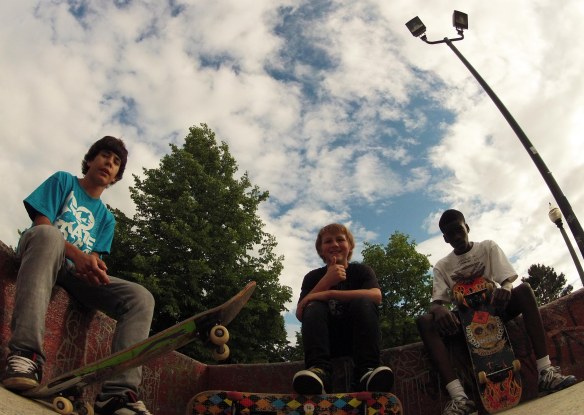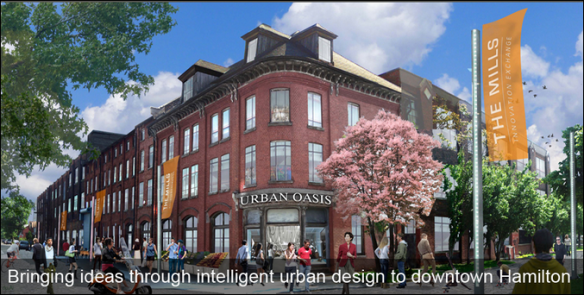Folks might remember Ocean Howell for his fancy footwork in videos such as H-Street’s Next (1991), but he has since become one of the most astute theorists of skateboard culture’s relationship to urban space and its development. After earning a PhD in architectural and urban history from the University of California, Berkley, Howell has gone on to become an Assistant Professor of History and Architectural History at the University of Oregon. His skateboarder’s sense of space and urban nuance, coupled with a keen desire for social justice, has lead him to publish numerous informative articles about the political dimensions of skateboarding culture.

Ocean flipping it out. Pic from http://skateandannoy.com/2007/10/disciplinary-architecture-and-ocean-howell/
“Skatepark as Neoliberal Playground” (2008) reviews parks management literature to reveal how the current political impetus to individualize risk and encourage entrepreneurial development over socialized responsibility is reinforced by the swath of new skateparks that have been popping up in the past decade. In “The Poetics of Security” (2001), Howell posits the rise of street skating as a response to the kinds of exclusionary and “defensive” urban development that began in the post-war period, then notes how authorities study subcultural users of space (like skateboarders) in order to design better ways of controlling marginalized or unwanted populations. In an article that provides a cautionary tale for those involved with Beasley Skate Park in Hamilton, Howell also looks at the case of Love Park in Philadelphia and shows how the skaters who frequented, then were banned from the space, were used as pawns in the city’s attempt to sanitize and gentrify the downtown plaza.
Howell defines gentrification as “any reclaiming of urban space by people of a higher economic position than the current users” (Creative Class 33). He shows how the cultural capital–the sense of “coolness” and distinction generated by skateboarders–was used by the city of Philadelphia to make downtown look attractive to middle and upper class citizens who were previously afraid to venture there. Skateboarders, much like artists, provide the “shock troops of gentrification” (33)–their use of the plaza helped drive away homeless people and other marginalized subjects that had begun to frequent there, largely due to the massive cuts in public spending on affordable housing projects and support programs for the mentally ill (a lasting legacy of the Reagan administration). But when this process of reclamation–of driving away “undesirables”–reached a certain point, the skaters themselves were banned and the space was redesigned to make it more difficult to skate.
 Skaters who want to remember the scene that flourished at Love Park in the 80s and 90s now must turn to memorial videos or buy the miniature plastic replica produced by Spin Master toys (zombie and “urban sanitizer” figurines not included).
Skaters who want to remember the scene that flourished at Love Park in the 80s and 90s now must turn to memorial videos or buy the miniature plastic replica produced by Spin Master toys (zombie and “urban sanitizer” figurines not included).
Neoliberalism is the name of the economic and political paradigm that has become increasingly dominant around the globe for the past three or four decades. It is the idea that the values of competition and market relationships (short-term, contractual and profit-oriented bonds) are the best way to organize all facets of social life, from schooling, to health care, to use of the environment. Favouring figures like entrepreneurs and venture-capitalists, Neoliberalism holds that societies work best when everyone is set loose to fend for themselves, with a minimum of government “interference,” regulation or support–unless, of course, you’re a big bank or company! (We can see here how the DIY ethic of contemporary skate culture might dovetail nicely with this paradigm–but we’ll get to that later.) Neoliberalism misconstrues the social sphere as a “level” playing field, where all actors have an equal opportunity to succeed, when in fact this model tends to favour the already wealthy, as the increasing polarization between rich and poor in even the most “advanced” of countries demonstrates. (The geographer David Harvey explains more about neoliberalism in this interview.)
One of the things I find most interesting in Howell’s analysis of contemporary skate culture is his observation that,
As the shock troops of gentrification, young skateboarders–with no personal memory of the postwar contract between labour and capital–must be understood as a kind of individualized labour, producing surplus value by leading the reclamation of space. (33)
Skaters who have grown up in the neoliberal era, Howell argues, do not have an experience that society could be arranged in a different way; they do not directly remember the period immediately following World War Two, when the competitive, individualizing tendencies of capitalism were mitigated by a strong sense of collective responsibility reflected in state programs and controls designed to ensure the well being of all citizens. It is one such program, in fact (to correct the record as it was presented in the Beaz Steez

short film, below), that supplied Derek Lapierre with the resources he needed to plan and implement the first Beasley Skate Jam, and to start Nomads magazine back in 1993. In fact, while skaters devised and ran these institutions themselves, they also had support from government run programs and the City’s Parks and Recreation department (whereas for the past two years, the skaters have had to raise the considerable fee for insurance coverage of their events themselves.)
In the above quote, Howell is countering the claim made by Iain Borden in his landmark book Skateboarding, Space and the City (2001), that skateboarding challenges the status quo of our production-oriented society because it is a “useless” form of labour that doesn’t generate material gains for the majority of practitioners, or for society in general (237, 88). However, as Howell shows, the individualized labour of skaters does produce a form of cultural capital, a surplus value that can then be appropriated by other parties and used to generate profit, as the City of Philadelphia did when the agreed to host the X-Games in 2002.
This is exactly what happens in the process of gentrification: artistically minded people like skaters and other producers of “organic,” street level culture contribute their energies and volunteer their time, largely out of love for their art or activity, or even out of a sense of civic-minded love for their city or neighbourhood. This produces a “scene” that is then attractive to the kinds of people who pride themselves on being interested in “culture”–everyone from downtown hipsters to suburban couples, well paid executives and university professors. When these people start to flock to an area, the artists might benefit from selling some of their art, making new connections, working in one of the new cafes or shops, but the people who really stand to make material gains are the property owners–those who have homes, businesses or rental units in the area. These people enjoy an increase in their property and rental values, thanks to the largely unpaid (or, if paid, then usually underpaid) labour of the artists and other cultural
producers.
The kicker is, these underpaid cultural producers are eventually displaced by the process they themselves had a hand in generating: as rents rise and a neighbourhood becomes more swanky, the artists are often pushed out (at which point they look for a new neighbourhood in which to settle, and the cycle begins again). Because most of us have grown up in an era that limits social responsibility to the paying taxes (without questioning whether these taxes are being spent on programs that will truly benefit those who need it most), we see this process as “natural” and we don’t stop to think how our society and neighbourhoods might be different. Would it be possible, for instance, to pay artists and cultural workers the wages they deserve (or at least a living wage)? to give them something akin to the benefits and security that was once enjoyed by workers in the industrial economy? Would it be possible to build neighbourhoods that guarantee a certain percentage of low income housing per block, to ensure that the “improvement” of a neighbourhood does not mean the implementation of structural changes that Howell describes as “quietly exclusionary” (Security pg.1)?
 Or, in the case of the Cannon Knitting Mills, a former industrial space in which the City of Hamilton has invested two million dollars of collective wealth to build an “innovation exchange,” why is there no sense that this “public/private” enterprise has a responsibility to the existing residents of the neighbourhood to provide spaces that reflect and cater to their needs in a way that might not be directly profitable? Sure, devote a fair percentage of the space to ventures that will help recoup the investment and even make a profit. However, given that a large portion of public funds are being spent on this project, a meaningful amount of space should be set aside for non-profit or low-profit, community uses that stand to benefit the people who have historically lived and worked in this neighbourhood. While the neoliberal model encourages us to play at urban renewal as if it were a zero-sum game (despite the utopian urban boosterism this hides behind), it does not have to be this way!
Or, in the case of the Cannon Knitting Mills, a former industrial space in which the City of Hamilton has invested two million dollars of collective wealth to build an “innovation exchange,” why is there no sense that this “public/private” enterprise has a responsibility to the existing residents of the neighbourhood to provide spaces that reflect and cater to their needs in a way that might not be directly profitable? Sure, devote a fair percentage of the space to ventures that will help recoup the investment and even make a profit. However, given that a large portion of public funds are being spent on this project, a meaningful amount of space should be set aside for non-profit or low-profit, community uses that stand to benefit the people who have historically lived and worked in this neighbourhood. While the neoliberal model encourages us to play at urban renewal as if it were a zero-sum game (despite the utopian urban boosterism this hides behind), it does not have to be this way!
Let’s return to Beasley Park itself. In the responses of numerous skaters, parents and neighbours that I have been interviewing for the Beaz Steez project, a common thread that appears is the strong sense of community that people experience when they are skating, hanging out, attending meetings, or taking an active hand in fixing up and preserving the park. It is this feeling of group belonging, of participation, and of mutual support and neighbourhood identity that distinguishes Beasley from the newer, smoother, and in many ways “better” Turner Skate Park in Hamilton’s southern suburb.
I would argue that it is this utopian feeling of belonging that also made nearby James St. North attractive to local artists like myself in the early phases of its redevelopment, about five years ago. What people often overlook in their romanticizing of this community dynamic, is its strong roots in working class culture and life. Though, as the literary critic Fredric Jameson aptly points out, the overarching tendency of capitalism is the dissolution of historic and ethnic, collectivist ties in favour of a fragmented, individualized consumer society,* it is the industrial working classes, who as a group were subjugated to similar strategies of policing, control and containment, that greatly contribute (alongside immigrants, social workers, neighbourhood activists, etc.) to the sense of community and mutual support that people cite as the defining characteristic of Beasley.
Because Hamilton historically was (and still is) a hub for heavy industry, this working class culture of support is still very strong. Richard Florida‘s idea of the “creative class”–of a kind of loose network of artists, tech industry workers, cultural produces, educators etc.–symbolizes the new formation that prominent developers hope will become the dominant paradigm for the production of value in the “post-industrial” cities like Hamilton. But because the “creative class” includes both well-paid professionals and struggling artists, the sense of solidarity, of “we’re all in this together,” that informs working class culture is not present in the same way. Creative class solidarity, if it really exists, is not grounded in a sense of collective struggle for rights and recognition the way working class culture is, but is rather held together by a certain aspirational feeling: those struggling to “make it” do not identify with the various low paying service jobs and short term contracts they have to work to make ends meet, but instead imaginatively place themselves in the position of the higher paid execs and professionals whom they hope to become. Underneath the community feeling that attends the arts and culture scene, this more individualistic, competitive and profit-oriented agenda is taking shape.
The middle class kids who have started to gravitate to Beasley, breathing new life into the park and inspired by the project of transformation that is underway, are also attracted by the working class sense of solidarity, and by the “authentic” feeling of working with concrete and paint that accompanies the current project. This sense of authenticity, however, is grounded in decades of working class struggle and cultural development. So there is some irony in the way this product of working class community is currently being mobilized to make the park attractive to a whole new class of people who find it appealing precisely because it offers something that is often missing in the suburbs: a sense of non-competitive, collective connection to people and common space. The problem is, this cultural fabric can rapidly morph into something else–something more akin to the competitive, aspirational but ultimately divisive and individualizing culture of the “creative class” and neoliberal urban development.
Of course, a certain amount of heroic investment and individualized competition is needed to keep a city vital within our current economic system, but the agents who promote this kind of change are often willfully blind about the limitations and damage that the “creative cities” model of development can cause. In order to prevent the loss of those very qualities that make Hamilton an interesting and affordable place to live, we should recognize the source of the value that is being generated at Beasley: it lies in the quiet but often colourful dignity of the lives and histories of innumerable workers, families, immigrants, artists, volunteers, social workers, organizers as well as more marginalized people who have “lived, worked and played” in Beasley for decades, and who have developed their own sense of culture grounded in a kind of shrewd humility, straight-forwardness and mutual support. Against a vision of the city that appropriates now desirable downtown spaces for a select group of middle class people and their commercial interests, it is important to recognize and fight for the common culture of the city. Parks and other non-commercial spaces provide important focal points, reminding us of the shared and collective nature of city space. It is not enough to install a plaque or raise a mural (though these are positive and welcome developments); what’s needed is recognition of the hard material realities faced by so many people in the whole of Hamilton’s struggling neighbourhoods, coupled with political and community policies that ensure the protection of housing, services, non-commercial public spaces, as well as livelihoods.
Since the mid-fifties, downtown Hamilton has been characterized by one-way streets and a kind of neo-gothic mixture of industrial, residential and business spaces (with a surprising amount of green–and sometimes “brown”–spaces and mixed in). These streets were designed with one thing in mind: getting workers and materials to the factories on time, regardless of the detrimental effect produced by five lane trafficways cutting through the centre of neighbourhoods. Now that middle class people are interested in living downtown again, there is a movement afoot to change these inner city highways back into calmer, more pedestrian and resident friendly two-way streets. This is a fine imperative, just so long as the recognition of the need for better living spaces doesn’t involve another ghettoization of workers and the impoverished in a kind of “out of sight, out of mind” strategy. One downtown entrepreneur I have talked to was optimistic about the changes that are sweeping through the core: “Hamilton is big enough to accommodate many different visions” he politicly said. But a city’s being “big enough” doesn’t mean shunting less fortunate people around like they were so many pieces of used furniture left by the curb. The services and amenities that many precariously positioned people depend upon are concentrated in the now contested space of the city centre, and shifting them further east or north only distances people from those facilities that ensure they enjoy a decent, or at least manageable, lifestyle.
When people try to optimistically cast Hamilton as a space of unlimited hope or potential, I question the position from which this sentiment is being volleyed. Is it one that recognizes the strong fabrics of support and interdependence that actually make the city a great place to live already, despite the culture shock that newcomers might experience while walking through downtown’s mixture of citizens? These networks are in place due to decades of social and everyday life struggle, and they have yet to be dissolved or dismantled despite attempts to launder our shared public spaces in a way that makes them more appealing to outsiders and investors. At this moment, the Beasley neighbourhood is a kind of nexus point for many of these struggles and challenges. In surveying the historical legacy of displacement and division that almost always accompanies gentrification, it is easy for a thinking person to become cynical. But every time I go to a neighbourhood meeting, or take part in projects like the recent Participatory Budgeting initiative, I feel a real sense of hope and amazement at just what “ordinary” people, people who are often thought to be of little or no account amongst the glitter and flash of current urban renewal rhetoric, are able to accomplish together.
Ocean Howell is skeptical regarding the claims of writers like Borden who characterize skateboarding as a politically transformative activity. Howell sees the practice of skater’s temporarily appropriating elements of the urban environment as a symptom of the loss of truly shared public spaces, calling skateboarding “an ineradicable residue of the public that persists in spaces that increasingly enforce privateness” (Security p.21). Skateboarders practicing on a handrail, bench or curb remind us that the vast majority of the spaces of our cities have been put toward a handful of limited, usually commercialized usages, and that even the seemingly shared spaces like plazas and parks have been subtly modified to exclude many of the kinds of people who live in cities.
But Beasley Park, due to its unique history and development, offers a different kind of space, one shaped and cared for by the people who use it and the neighbourhood and city that has supported their efforts. This heritage, of course, can be commoditized in its own way, by both a skateboard industry that is eager to attach its logos to the common space of the park, and by a larger gentrification project that seizes the cultural capital of skaters to make the space more exciting and appealing to investors. Skateboarding itself has been criticized for its exclusivity in the way it appeals mainly to young men, and is often uncomfortable with or even hostile to gay culture. If these tendencies to exclusion and privatization can be resisted and challenged there is a chance that Beasley Park can remain a kind of landmark to our vanishing commons, supplying a living example that the cities we share can be places where everyone is made to feel welcome and wanted.
*”The historically unique tendencial effect of late capitalism on all such [unified] social groups has been to dissolve and to fragment or atomize them into agglomerations (Gesellschaften) of isolated and equivalent private individuals, by way of the corrosive action of universal commodification and the market system.” Fredric Jameson, “Reification and Mass Utopia,” Social Text 1 (1979), p.134.












